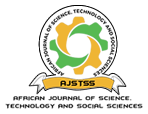Use of sensor based drip irrigation in improving irrigation water efficiency for vegetable crops Tharaka Nithi county
DOI:
https://doi.org/10.58506/ajstss.v1i1.38Keywords:
Sensor based irrigation, Smart irrigation, Drip irrigationAbstract
Drip irrigation is a water saving technology recommendable for ASAL regions of Kenya that are water deficit. However, it is largely manually operated in Kenya, leading to variable irrigation water use efficiency (IWUE). This necessitates automating the irrigation. Sensor based irrigation has been developed at Meru University of Science and Technology. In this study, the system was configured for use in ASALs areas of Kenya. The system has an electronic gadget designed to automate irrigation. It is fitted with soil moisture sensors and motorized water valves. The sensors are installed near the crop root zone. When soil moisture drops below a predetermined threshold, the pump and the valves are triggered to switch ON automatically and start supplying water to the crops. When adequate water has been supplied, the sensors detect trigger the pumps and motorized valves to switch OFF hence cutting the water supply to the crops. The system was validated at Mukothima in Tharaka Nithi, an ASAL region in Kenya between April and August 2021 using water melon (Sukari F1) and onion (Red creole) as test crops. A randomized complete block design with three replications was used with three irrigation systems; sensor based drip, manually drip and furrow irrigation. Data was collected on vegetative growth and yield, soil moisture and irrigation water used. Farmers were invited to evaluate the crops during the vegetative stage. There were no significant differences in vegetative growth and fruit yield of water melon and bulb yield of onions between the irrigation systems. Soil moisture tended to be high in furrow irrigation. Irrigation water used was significantly higher in furrow irrigation and lowest in the sensor based drip irrigation. This led to a significantly higher IWUE in sensor based drip irrigation. Farmers evaluation did not detect significant differences in the crops between the irrigation systems. It is concluded that use of sensor based drip irrigation is able to enhance efficiency of irrigation water use while at the same time giving productivity of crops similar to the common methods of irrigation used in ASALs.


